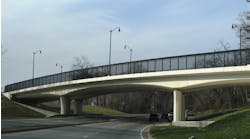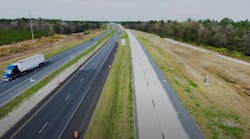A $1 billion construction project is under way to replace Doyle Drive, the 1.5-mile portion of Highway 101 that connects the city of San Francisco and the Golden Gate Bridge.
Built in 1936, Doyle Drive is structurally and seismically deficient and is facing the same problem that threatens other crucial components of the nation’s infrastructure: the ravages of time and continual use. In this case, more than 140,000 people use the corridor each weekday.
The replacement of Doyle Drive with the new Presidio Parkway design is a collaborative effort led by the California Department of Transportation (Caltrans), the San Francisco County Transportation Authority and the Federal Highway Administration (FHWA). The start of construction of the Presidio Parkway was accelerated by more than a year by a $122 million infusion of funding from the American Recovery and Reinvestment Act. As a result, design was expedited and construction began in December 2009, just one year after the FHWA’s record of decision and the close of the environmental process.
The project is located within the Presidio of San Francisco and the Golden Gate National Recreation Area, one of the nation’s largest urban parks and a National Historic Landmark District. The area attracts thousands of visitors and recreationists each day and is home to residents and businesses located directly adjacent to the project area. The unique project setting and sensitive surroundings have guided the design development process, construction phasing and the techniques used to build the future Presidio Parkway in order to minimize the project’s impacts to the area.
Originally built when the Presidio was a military base, Doyle Drive is currently an elevated roadway designed to restrict access to the Presidio. The Presidio was converted to a national park in 1994. The replacement project provides an opportunity to re-envision the freeway as a parkway reduced in size and scale, with modern design improvements that complement the spectacular surroundings. Key design elements include wide landscaped medians, continuous shoulders, twin bridges with wide spans for enhanced views, two sets of short cut-and-cover tunnels and a new interchange providing direct access to the Presidio.
Just phasing through
Carefully planned construction phasing has been paramount in order to keep traffic moving while rebuilding this critical transportation link. Along with phasing and temporary structures for individual construction elements, the entire project is divided into two major phases to minimize disruption to the traveling public and allow the corridor to remain open during construction.
The first phase, currently under way, involves construction of the new southbound Presidio Viaduct, southbound Battery Tunnel and an at-grade temporary bypass at the eastern end of the project. Including a temporary road in construction phasing keeps traffic flowing adjacent to construction activity, while Caltrans completes the full replacement of Doyle Drive, and will expedite construction by 11?2 years. Seismic safety will be achieved once traffic is shifted onto these completed structures, which is expected to occur in late 2011.
During the second phase the newly built structures will carry traffic in both directions, separated by a movable median barrier, while the existing Doyle Drive is demolished and the remaining roadway and structures are built. There will be two full weekend closures of Doyle Drive in order to accomplish the key traffic shifts between phases.
Take in the view, take on an earthquake
The Presidio Viaduct is more than 1,300 ft long and stands as high as 115 ft above Cavalry Hollow, the National Park Service horse stables and a pet cemetery where local residents laid their animals to rest. The viaduct was designed with fewer columns and three 275-ft-long main spans in order to open views to the San Francisco Bay and surrounding area. More importantly, the Presidio Viaduct was designed to withstand the maximum credible earthquake for this seismic region. The bedrock depth and geological conditions vary widely along the bridge alignment and include clay, dense sand, loose silt and a high water table, which can be prone to liquefaction. To account for this, the Presidio Viaduct includes large, 12-ft-diam. foundations, up to 200 ft in length, with permanent steel casings, unique hoop configurations and steel-reinforced rock sockets. Column isolation casings also were employed to reduce stiffness and meet seismic criteria.
In order to dig the huge foundations and still meet the restrictive noise and vibration requirements for the contract, a one-of-a-kind, 180,000-lb oscillator was purchased specifically for the Presidio Parkway project. The machine twists the steel casings down to reduce disruption to the surrounding ground, minimizing vibration effects on nearby historic and natural resources and greatly reducing the noise associated with more traditional, brute force pile driving.
Unlike a traditional box-girder bridge, the Presidio Viaduct has a sleek look with especially long overhang sections partially supported by steel fins which reflect the design of the existing bridge’s steel truss. The largest fins are approximately 12 ft long by 9.5 ft tall and vary geometrically along the bridge profile. There are 256 fins in total, positioned approximately every 15 ft along the new bridge and weighing as much as 3,000 lb each. The fins will eventually be painted International Orange like the nearby Golden Gate Bridge.
The Presidio Viaduct structural section varies in depth from 6.6 to 12.9 ft and includes increased detailing for prestressing the bridge with longitudinal, transverse and deck stressing. Some of the bent caps required cooling tubes, since they were large enough to employ mass concrete specifications. The superstructure also includes a seismic joint to increase flexibility and movement in the event of an earthquake.
Another challenge to building the Presidio Viaduct included preserving a pet cemetery located directly below the new southbound bridge. In order to protect the pet cemetery during construction and support falsework over the cemetery, 105-ft-long, 8-ft-deep precast, prestressed concrete girders were trucked in at night under permit load conditions, supporting the falsework posts.
High on Battery
Another key feature of phase one is the southbound Battery Tunnel, one of two sets of twin tunnels that will enhance the connection between the Presidio and Crissy Field along the San Francisco Bay and provide access to formerly isolated historic military batteries. Tunnels are a signature design element of the new Presidio Parkway, lowering the roadway and making room for more park land by covering over the short tunnels with green space and trail networks.
The southbound Battery Tunnel is located in a very tight space between the San Francisco National Cemetery and the existing Doyle Drive. The project team worked closely with the Department of Veterans affairs to ensure protection of the cemetery land and historic resources. A shoring system of struts and tie backs was designed to support a 30- to 40-ft cut, minimize deflection and still allow for efficient removal of nearly 100,000 cu yd of material. To complete the 1,100-ft tunnel, a traveler form system will be used to cast in place 65-ft sections of the slab. Concrete mix designs were analyzed to give high early strengths to expedite the construction.
Another challenge was to design the tunnel systems substation which, due to the lack of available space and the project’s architectural criteria, needed to be hidden within the structure between the Presidio Viaduct and the Battery Tunnel. The substation will house the extensive systems needed to run tunnel lighting, electrical, fire suppression and jet fans. 3-D modeling was utilized to help visualize and analyze options and determine the most space-efficient and constructible solution. With the 3-D modeling, project designers developed a system to reduce bends in rigid conduit and develop a more efficient, accessible substation.
A temp job
Construction of a five-lane temporary bypass road at the eastern end of the project enables traffic to continue flowing while the final roadway is built and the existing Doyle Drive is demolished. Due to the relatively high groundwater table in the surrounding area, and to reduce the risk of settlement, the temporary bypass embankment is being constructed with lightweight fill material consisting of cellular concrete with a cast density between 27 and 30 pcf. The temporary bypass will be removed once traffic is transferred onto the final Presidio Parkway in 2014.
The light signals have been installed and grading is complete for the new intersection connecting the temporary bypass to Marina Boulevard and Richardson Avenue.
Being dramatic
Upon completion of the Presidio Parkway in 2014 and final landscaping in 2015, San Francisco will have experienced the most dramatic transformation of its waterfront since the restoration of Crissy Field and the removal of the Embarcadero freeway. Drivers will travel on a seismically safe roadway with improved views of San Francisco and the bay, while visitors and recreationists in the Presidio will enjoy increased green space and bike and trail networks for years to come.


